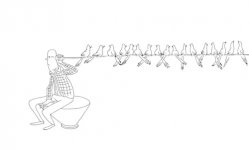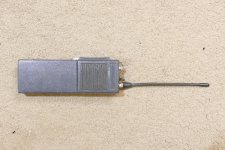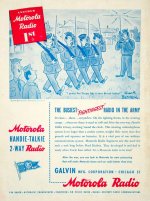Does anybody else here feel that saying random ridiculous stuff feels very satisfying, preferably spoken, but written as well? I hesistate to give an example, but am curious about what other people have to say about this.
OK, right so (I sound Irish), those are examples of random stuff, not as random as I am talking about but, what do you think about expressing such thoughts? (not trying to play a psychanalyst here, just curious)
Zoom and others opened up a new world of communication that had not been widely used outside the corporate world until Covid came. We (Motorola) had been using video meetings for years, so it was not a new experience, but it was often amusing to spot someone's walkie talkie sitting on the table near the meeting controller in a conference room and subject them to world wide embarrassment by making rude noises or comments through their walkie talkie which were heard worldwide (we had IC chip design teams on 4 continents). All of our radios transmitted their unique ID on every transmission. The plant had its own trunking radio system in house and the system controller was local so anyone with access privileges could look at the logs to see who sent each transmission, so to protect the sender and invoke greater mystery one would use a cloned ID, usually one belonging to another person needing disrespect, say the boss mentioned above. I must mention that cloning ID's was not possible 😉
The Sparc workstation on my desk in the think tank had some great audio processing tools. It was fairly easy to grab someone's transmission from a walkie talkie, edit it a bit, then replay it through the radio network, or out of the speaker on any Sparc station on the Motorola network. this provided lots of fun until the UNIX / Solaris gurus figured out how to trace us.
Another excellent practical joke, grab a screen shot of someone's computer. Wait a day or two then turn that shot into a screen saver image and remotely install it to the unsuspecting user while he is out to lunch. When he returns it will appear that his last two days of work vanished. After the initial panic subsides and the user moves the mouse his work will be magically restored.
Another manager was often heard yelling Bull$#@t at the top of his volume range in the off campus think tank. Several people in the office were not amused, especially those who spent their day on the phone, so I captured a recording of this and created a DOS batch file to play this out of the speakers on his own PC every time he turned it on.
Yes, these were the days of 286 and 386 PCs, DOS and Windows 3.1 in a time when computer security wasn't an issue. Many people did not use lock screens or even log out when they left for the day so pranks were easy and common. One of my coworkers got on my PC and sent a "love letter" from my email to my bosses email (also male). Fortunately to myself and the boss it was an obvious prank, one that would be repaid over the years.....with interest.....compounded daily until a truce was called.
So, basically, you were Dilbert and your boss was the pointy-haired guy!Some people are well known in their place of employment and after 41 years of working in the same place many knew who I was. Most knew me for being willing to try almost anything once, blowing stuff up of course, and other similar antics (ever freeze an apple in liquid nitrogen then hit it with a hammer, "erase" a UV Eprom with a 200 watt laser or an X-ray machine). There was however one simple incident that remained associated with me for at least 10 years.
I worked in the product design team that was developing a state of the art two way radio for public safety (police, fire...) use back in the early 1990's. Since we made two way radios in house, and we were all essentially beta testers nearly every employee in engineering (several thousand at the time) carried a walkie talkie. Our radios had several modes, private call (a one to one conversation), group call ( a one to many, usually the entire department) and fleet call (all of engineering). Most calls were private, or group to address the required audience without disturbing everyone else. I had an idiot boss who did not know an ohm from a gigawatt, was quite impulsive, and had a general reputation for being an A$$. I was occupied one day when my radio squawked "Anderson I need you in my office NOW" to which I replied "I'm busy." This guy always did these kind of things using fleet call to demonstrate his dominance. A few seconds later he came back with some more demanding version of the same request including some profanity which I did not answer. The next transmission was his distorted voice (from yelling directly into the mic) screaming "Anderson, where are you." At this point I had finished my task, so I simply keyed the radio on a fleet call, held it in the bowl, and flushed. There were no further replies, but there was a good deal of cheer and laughter when I walked back into the department. The boss just had another of his stupid ideas to solve a technical issue which just demonstrated his lack of knowledge of basic electronics.
This would become the defining moment for which I was known around the Motorola plant for several years. It was also the catalyst that allowed me to escape that tyrant's rule and go work in an off campus think tank for a few years which was a neat learning experience. As soon as that way overdue project was completed, that boss was put in charge of a far lesser program, and eventually "encouraged" to leave the company.
Glad at last you took your mask off and showed your true self 🙂
There were multiple Dilberts and pointy haired bosses in that place.So, basically, you were Dilbert and your boss was the pointy-haired guy!
Some of the artistically gifted people in that place often drew colorful "dilbert" cartoons on the whiteboards around the campus, sometimes using real names. Enclosed is the "last cartoon" drawn by the "dilbert" artist on the day that about 500 people were laid off. Yes, she was often seen with the cat hat or some other colorful accessories in the building.
I do remember seeing a cartoon with a yellow haired Dilbert that appeared after a 6 hour meeting. It was a poop storm created by some "experts" without a clue who brought together about 25 good engineers to determine what caused a badly burnt customer return cell phone that had shut down production. I had stated the obvious cause in the first 20 minutes, but was ignored as "not serious." When the meeting was still in the argumentative and "blame storming" stage at nearly 2PM without a lunch break, I ended it abruptly when a similar cell phone met the microwave oven with nearly identical results.
So true. In the early days of Dilbert there was some speculation that Scott Adams must have actually worked at Motorola, or some place like it. This was before the WWW had really taken off as Netscape Navigator didn't exist until 1995. Rumor was that he worked at AT&T, which did turn out to be partially true. Scott did several years at Pacific Bell before Dilbert, and PAC BELL would have been AT&T before the breakup.Dilbert was not a satire. It was a documentary.
Most of my crazy "science experiments" came during a time when I was an evening shift Mr. Fixit for the factory (1975 to 1985). Imagine several technically minded friends with access to over half a million square feet of manufacturing technology to make things or play with stuff and no bosses around to police the place. At the time Motorola was nearly totally vertically integrated. We not only made radios, pagers, base stations, and control systems in house, but we also made many of the parts that went into them from quartz crystals to laser trimmable chip resistors. When the cat's away, the mice will play, or make cool stuff. We cloned every Tiger amp SWTPC made except Tigersaurus and we cloned the SWTPC 6800 computer too.
Attachments
[envy] [envy] [envy] [envy] [envy] [envy]Imagine several technically minded friends with access to over half a million square feet of manufacturing technology to make things or play with stuff and no bosses around to police the place. At the time Motorola was nearly totally vertically integrated. We not only made radios, pagers, base stations, and control systems in house, but we also made many of the parts that went into them from quartz crystals to laser trimmable chip resistors. When the cat's away, the mice will play, or make cool stuff. We cloned every Tiger amp SWTPC made except Tigersaurus and we cloned the SWTPC 6800 computer too.
🙂 🙂 🙂
Being my own boss, I also had the freedoms to explore, test, and improve upon many products at the repair shop.
The cost-cutting of mass production, the built-in life expectancy created by greed, etc.
And the education that resulted from watching through the decades how once proud and well-run corporations began to hop on the boat together to lose their respectability and once-high reputations.
The cost-cutting of mass production, the built-in life expectancy created by greed, etc.
And the education that resulted from watching through the decades how once proud and well-run corporations began to hop on the boat together to lose their respectability and once-high reputations.
I spent about 5 years working in consumer electronics repair starting at age 15 in a TV repair shop. I agree that even in 1967 the quality of some once great electronics company was in decline. By age 20 I had decided that I wasn't going to be a rock star, and I didn't like the repair world, because as you probably know 10% of your customers cause 90% of your problems. I left that world and got a job as a tech on the end of the HT-220 assembly line. It gives you a deeper knowledge into electronics repair when you are fixing something that never worked at all before, even a little, and had about a 50% chance of being incorrectly built. After 2 years of that crap, I got the Mr. Fixit job which gave me the keys to the entire factory. After 10 years of that, it became obvious to me that the days of the factory itself were numbered, so I worked my way into engineering. Product design, especially where the user's life may be dependent on that radio working is a far different game than consumer electronics. For once, cost is no object, and product quality is the driving factor.
The radio in the picture is a UHF Motorola HT-220 from about 1972. This is what I worked on when I started. This one still works fine after 50 years and what looks like considerable use. The plastic is well worn, and the Motorola label has fallen off. It is one of the simple single frequency 1 watt models with Privivate Line (TCS). There are two PC boards inside both hand stuffed by workers on an assembly line. It contains 3 simple custom IC's a handful of silicon transistors and two germanium transistors. Motorola still makes the best (and most expensive) two way radios in the world today. All other uses of the "Motorola" brand belong to other companies, some of which make mediocre quality consumer stuff.
I remember several of the people pictured in the "dream come true" article linked here
https://mfwright.com/HT220.html
I just read the "working the dream come true from a Motorola technician." There is mention of a VHF HT-220 that put out "almost 25 watts in stock condition." That is not entirely true. I know this because I was the guy who made that radio. A "stock" 5 watt anything isn't going to make 25 watts, especially with 1970's transistors. The 1.8 watt radio uses the on board RF power amp to make 1.8 watts. The 5 watt radio uses an additional power amp added to boost that to 5 watts. I added a second additional power amp whose output device had been swapped for a part from a 25 watt VHF marine radio. The radio did appear stock from the outside. Heat was a problem, but battery life was measured in minutes, so the battery would die before the power amp melted. We used this for finding leaks in the RF screen rooms used to test live transmitters.
I worked in that NIST certified calibration lab in "the new Plantation plant" mentioned in the article, also on the evening shift for 10 years. Thats where I got the keys to the factory.
The radio in the picture is a UHF Motorola HT-220 from about 1972. This is what I worked on when I started. This one still works fine after 50 years and what looks like considerable use. The plastic is well worn, and the Motorola label has fallen off. It is one of the simple single frequency 1 watt models with Privivate Line (TCS). There are two PC boards inside both hand stuffed by workers on an assembly line. It contains 3 simple custom IC's a handful of silicon transistors and two germanium transistors. Motorola still makes the best (and most expensive) two way radios in the world today. All other uses of the "Motorola" brand belong to other companies, some of which make mediocre quality consumer stuff.
I remember several of the people pictured in the "dream come true" article linked here
https://mfwright.com/HT220.html
I just read the "working the dream come true from a Motorola technician." There is mention of a VHF HT-220 that put out "almost 25 watts in stock condition." That is not entirely true. I know this because I was the guy who made that radio. A "stock" 5 watt anything isn't going to make 25 watts, especially with 1970's transistors. The 1.8 watt radio uses the on board RF power amp to make 1.8 watts. The 5 watt radio uses an additional power amp added to boost that to 5 watts. I added a second additional power amp whose output device had been swapped for a part from a 25 watt VHF marine radio. The radio did appear stock from the outside. Heat was a problem, but battery life was measured in minutes, so the battery would die before the power amp melted. We used this for finding leaks in the RF screen rooms used to test live transmitters.
I worked in that NIST certified calibration lab in "the new Plantation plant" mentioned in the article, also on the evening shift for 10 years. Thats where I got the keys to the factory.
Attachments
Last edited:
Motorola still makes the best (and most expensive) two way radios in the world today.
That's a cue for a Motorola 2-way radio cartoon!
Attachments
And the education that resulted from watching through the decades...
From Hi-Fi to Wi-Fi, you've seen it all! 🙂
I thought that looked familiar so did some search. Briareos from Japanese anime series called "Appleseed" came up. 🤔as an "Alien Biker"
- Home
- Member Areas
- The Lounge
- Something to lighten the mood




